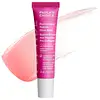What's inside
What's inside
 Key Ingredients
Key Ingredients

 Benefits
Benefits

 Concerns
Concerns

 Ingredients Side-by-side
Ingredients Side-by-side

Hydrogenated Polyisobutene
EmollientPolybutene
Diisostearyl Malate
EmollientBis-Diglyceryl Polyacyladipate-2
EmollientGlyceryl Behenate
EmollientSynthetic Beeswax
Emulsion StabilisingCaprylic/Capric Triglyceride
MaskingButyrospermum Parkii Butter
Skin ConditioningCetearyl Ethylhexanoate
EmollientEthylhexyl Palmitate
EmollientRicinus Communis Seed Oil
MaskingDimethyl Isosorbide
SolventPalmitoyl Tripeptide-1
Skin ConditioningPalmitoyl Tripeptide-38
Skin ConditioningTridecapeptide-1
Skin ConditioningSesamum Indicum Seed Extract
Skin ConditioningPortulaca Pilosa Extract
Skin ConditioningPentylene Glycol
Skin ConditioningPrunus Domestica Seed Oil
Skin ConditioningWater
Skin ConditioningSodium Hyaluronate
HumectantTribehenin
EmollientSorbitan Isostearate
EmulsifyingHydrogenated Castor Oil
EmollientLactic Acid
BufferingTocopherol
AntioxidantSucrose Cocoate
EmulsifyingVanillin
MaskingCI 15850
Cosmetic ColorantHydrogenated Polyisobutene, Polybutene, Diisostearyl Malate, Bis-Diglyceryl Polyacyladipate-2, Glyceryl Behenate, Synthetic Beeswax, Caprylic/Capric Triglyceride, Butyrospermum Parkii Butter, Cetearyl Ethylhexanoate, Ethylhexyl Palmitate, Ricinus Communis Seed Oil, Dimethyl Isosorbide, Palmitoyl Tripeptide-1, Palmitoyl Tripeptide-38, Tridecapeptide-1, Sesamum Indicum Seed Extract, Portulaca Pilosa Extract, Pentylene Glycol, Prunus Domestica Seed Oil, Water, Sodium Hyaluronate, Tribehenin, Sorbitan Isostearate, Hydrogenated Castor Oil, Lactic Acid, Tocopherol, Sucrose Cocoate, Vanillin, CI 15850
Theobroma Cacao Seed Butter
EmollientBis-Diglyceryl Polyacyladipate-2
EmollientButyrospermum Parkii Butter
Skin ConditioningGlyceryl Rosinate
PerfumingHydrogenated Polyisobutene
EmollientCanola Oil
EmollientCrambe Abyssinica Seed Oil Phytosterol Esters
EmulsifyingOlea Europaea Oil Unsaponifiables
Skin ConditioningWater
Skin ConditioningIsohexadecane
EmollientHydrogenated Lecithin
EmulsifyingRetinyl Retinoate
Skin ConditioningCurcuma Longa Root Extract
MaskingSodium Hyaluronate
HumectantTripeptide-1
Skin ConditioningCera Alba
EmollientSqualene
EmollientPalmitic Acid
EmollientAroma
C12-16 Alcohols
EmollientEthylene/Propylene/Styrene Copolymer
Glycine Soja Oil
EmollientButylene/Ethylene/Styrene Copolymer
Xanthan Gum
EmulsifyingCitric Acid
BufferingPseudoalteromonas Ferment Extract
HumectantSalicylic Acid
MaskingSodium Salicylate
PreservativeTocopherol
AntioxidantLimonene
PerfumingBeta-Sitosterol
Emulsion StabilisingEucalyptus Globulus Leaf Oil
PerfumingTocopheryl Acetate
AntioxidantPhenoxyethanol
PreservativeTheobroma Cacao Seed Butter, Bis-Diglyceryl Polyacyladipate-2, Butyrospermum Parkii Butter, Glyceryl Rosinate, Hydrogenated Polyisobutene, Canola Oil, Crambe Abyssinica Seed Oil Phytosterol Esters, Olea Europaea Oil Unsaponifiables, Water, Isohexadecane, Hydrogenated Lecithin, Retinyl Retinoate, Curcuma Longa Root Extract, Sodium Hyaluronate, Tripeptide-1, Cera Alba, Squalene, Palmitic Acid, Aroma, C12-16 Alcohols, Ethylene/Propylene/Styrene Copolymer, Glycine Soja Oil, Butylene/Ethylene/Styrene Copolymer, Xanthan Gum, Citric Acid, Pseudoalteromonas Ferment Extract, Salicylic Acid, Sodium Salicylate, Tocopherol, Limonene, Beta-Sitosterol, Eucalyptus Globulus Leaf Oil, Tocopheryl Acetate, Phenoxyethanol
 Reviews
Reviews

Alternatives
Ingredients Explained
These ingredients are found in both products.
Ingredients higher up in an ingredient list are typically present in a larger amount.
This ingredient is lipid-based synthetic skin-conditioning agent derived from adipic acid and a mixture of fatty acids. It is often called a lanolin substitute.
As an emollient, it helps soften and hydrate the skin. Emollients create a barrier on the skin to trap moisture in.
Due to its fatty acid base, it may not be Malassezia folliculitis safe.
Learn more about Bis-Diglyceryl Polyacyladipate-2This ingredient is also known as shea butter. It is an effective skin hydrator and emollient.
Emollients help soothe and soften your skin. It does this by creating a protective film on your skin. This barrier helps trap moisture and keeps your skin hydrated. Emollients may be effective at treating dry or itchy skin.
Shea butter is rich in antioxidants. Antioxidants help fight free-radicals, or molecules that may harm the body. It is also full of fatty acids including stearic acid and linoleic acid. These acids help replenish the skin and keep skin moisturized.
While Shea Butter has an SPF rating of about 3-4, it is not a sunscreen replacement.
Shea butter may not be fungal acne safe. We recommend speaking with a professional if you have any concerns.
Learn more about Butyrospermum Parkii ButterHydrogenated Polyisobutene is a synthetic polymer. Polymers are compounds with high molecular weight. Hydrogenated Polyisobutene is an emollient and texture enhancer.
In one study, Hydrogenated Polyisobutene showed better skin hydration levels than Caprylic/Capric Triglyceride. As an emollient, it helps keep your skin soft and hydrated by trapping moisture in.
Hydrogenated Polyisobutene is often used as a mineral oil replacement.
Learn more about Hydrogenated PolyisobuteneSodium Hyaluronate is hyaluronic acid's salt form. It is commonly derived from the sodium salt of hyaluronic acid.
Like hyaluronic acid, it is great at holding water and acts as a humectant. This makes it a great skin hydrating ingredient.
Sodium Hyaluronate is naturally occurring in our bodies and is mostly found in eye fluid and joints.
These are some other common types of Hyaluronic Acid:
Learn more about Sodium HyaluronateTocopherol (also known as Vitamin E) is a common antioxidant used to help protect the skin from free-radicals and strengthen the skin barrier. It's also fat soluble - this means our skin is great at absorbing it.
Vitamin E also helps keep your natural skin lipids healthy. Your lipid skin barrier naturally consists of lipids, ceramides, and fatty acids. Vitamin E offers extra protection for your skin’s lipid barrier, keeping your skin healthy and nourished.
Another benefit is a bit of UV protection. Vitamin E helps reduce the damage caused by UVB rays. (It should not replace your sunscreen). Combining it with Vitamin C can decrease sunburned cells and hyperpigmentation after UV exposure.
You might have noticed Vitamin E + C often paired together. This is because it is great at stabilizing Vitamin C. Using the two together helps increase the effectiveness of both ingredients.
There are often claims that Vitamin E can reduce/prevent scarring, but these claims haven't been confirmed by scientific research.
Learn more about TocopherolWater. It's the most common cosmetic ingredient of all. You'll usually see it at the top of ingredient lists, meaning that it makes up the largest part of the product.
So why is it so popular? Water most often acts as a solvent - this means that it helps dissolve other ingredients into the formulation.
You'll also recognize water as that liquid we all need to stay alive. If you see this, drink a glass of water. Stay hydrated!
Learn more about Water